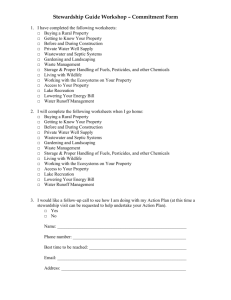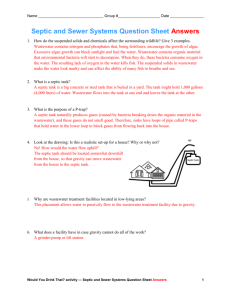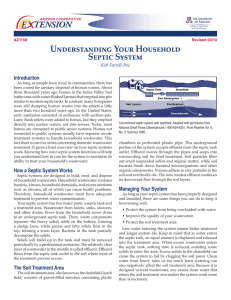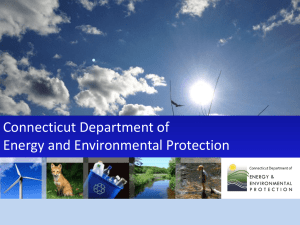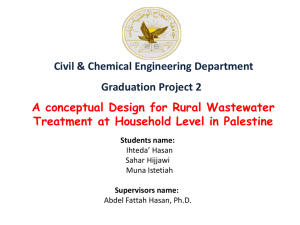RV Holding-tank Treatments & Deodorizers in Septic Systems Kitt Farrell-Poe
advertisement
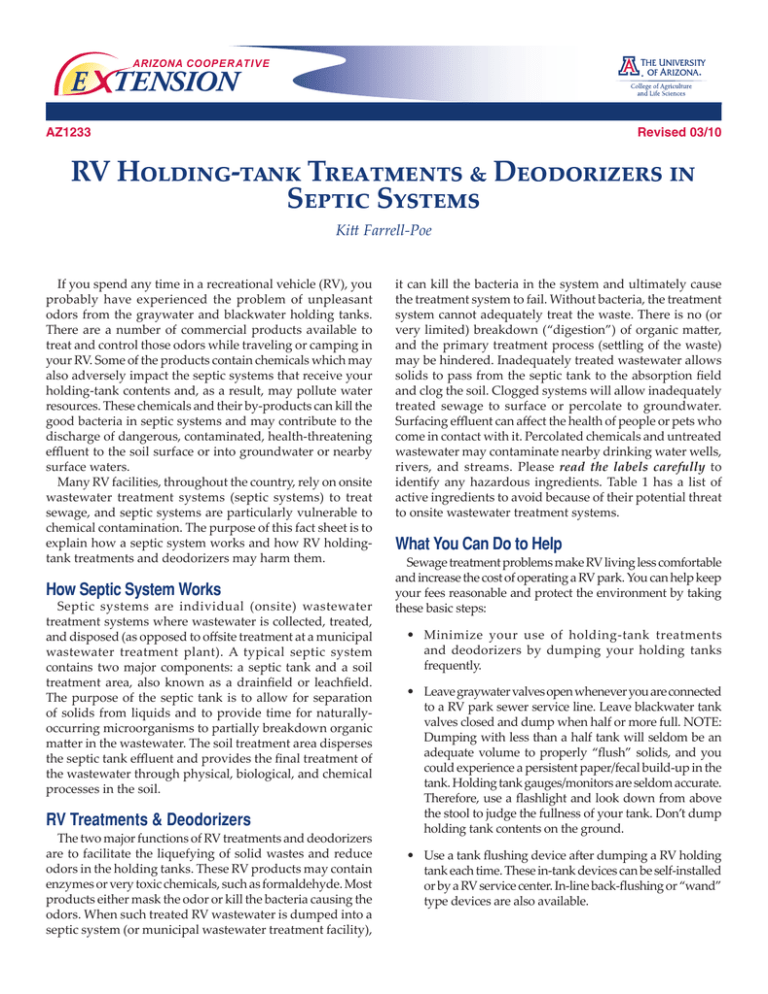
ARIZONA COOP E R AT I V E E TENSION Revised 03/10 AZ1233 RV Holding-tank Treatments & Deodorizers in Septic Systems Kitt Farrell-Poe If you spend any time in a recreational vehicle (RV), you probably have experienced the problem of unpleasant odors from the graywater and blackwater holding tanks. There are a number of commercial products available to treat and control those odors while traveling or camping in your RV. Some of the products contain chemicals which may also adversely impact the septic systems that receive your holding-tank contents and, as a result, may pollute water resources. These chemicals and their by-products can kill the good bacteria in septic systems and may contribute to the discharge of dangerous, contaminated, health-threatening effluent to the soil surface or into groundwater or nearby surface waters. Many RV facilities, throughout the country, rely on onsite wastewater treatment systems (septic systems) to treat sewage, and septic systems are particularly vulnerable to chemical contamination. The purpose of this fact sheet is to explain how a septic system works and how RV holdingtank treatments and deodorizers may harm them. How Septic System Works Septic systems are individual (onsite) wastewater treatment systems where wastewater is collected, treated, and disposed (as opposed to offsite treatment at a municipal wastewater treatment plant). A typical septic system contains two major components: a septic tank and a soil treatment area, also known as a drainfield or leachfield. The purpose of the septic tank is to allow for separation of solids from liquids and to provide time for naturallyoccurring microorganisms to partially breakdown organic matter in the wastewater. The soil treatment area disperses the septic tank effluent and provides the final treatment of the wastewater through physical, biological, and chemical processes in the soil. RV Treatments & Deodorizers The two major functions of RV treatments and deodorizers are to facilitate the liquefying of solid wastes and reduce odors in the holding tanks. These RV products may contain enzymes or very toxic chemicals, such as formaldehyde. Most products either mask the odor or kill the bacteria causing the odors. When such treated RV wastewater is dumped into a septic system (or municipal wastewater treatment facility), it can kill the bacteria in the system and ultimately cause the treatment system to fail. Without bacteria, the treatment system cannot adequately treat the waste. There is no (or very limited) breakdown (“digestion”) of organic matter, and the primary treatment process (settling of the waste) may be hindered. Inadequately treated wastewater allows solids to pass from the septic tank to the absorption field and clog the soil. Clogged systems will allow inadequately treated sewage to surface or percolate to groundwater. Surfacing effluent can affect the health of people or pets who come in contact with it. Percolated chemicals and untreated wastewater may contaminate nearby drinking water wells, rivers, and streams. Please read the labels carefully to identify any hazardous ingredients. Table 1 has a list of active ingredients to avoid because of their potential threat to onsite wastewater treatment systems. What You Can Do to Help Sewage treatment problems make RV living less comfortable and increase the cost of operating a RV park. You can help keep your fees reasonable and protect the environment by taking these basic steps: • Minimize your use of holding-tank treatments and deodorizers by dumping your holding tanks frequently. • Leave graywater valves open whenever you are connected to a RV park sewer service line. Leave blackwater tank valves closed and dump when half or more full. NOTE: Dumping with less than a half tank will seldom be an adequate volume to properly “flush” solids, and you could experience a persistent paper/fecal build-up in the tank. Holding tank gauges/monitors are seldom accurate. Therefore, use a flashlight and look down from above the stool to judge the fullness of your tank. Don’t dump holding tank contents on the ground. • Use a tank flushing device after dumping a RV holding tank each time. These in-tank devices can be self-installed or by a RV service center. In-line back-flushing or “wand” type devices are also available. NOTE: don’t use potable drinking water hoses for such activities. • When using a holding-tank treatment or deodorizer, read the label and follow the directions carefully. REMEMBER, excessive amounts of RV holdingtank treatments or deodorizers and those not recommended by the manufacturer can and will disrupt the wastewater treatment system you dump into. Consider using only enzyme-based or bacterial-based products. Please note that the term biodegradable does not necessarily mean that the product is safe for humans or the environment. Never use bleach to treat or “sweeten” a tank. Bleach can severely and quickly damage valves, seals, and gaskets. Active Ingredient Bronopol (chemical name: bromo-nitropropane-diol) Dowicil (chemical name: 1-(3-chlorallyl)-3,4,7-triaza-1azoniaadamantane chloride) Formaldehyde (also known as Formalin; degradate of bronopol) Glutaraldehyde (also known as embalming fluid) Paraformaldehyde (polymerized formaldehyde) Para-dichlorobenzene (common ingredient in mothballs, urinal cakes, and toilet bowl fresheners) • Ask questions of your park manager about drinking (potable) water and wastewater management. Sanitation costs can be minimal, but are not free. • Educate other RVers. Don’t be shy about your health or the health of the environment. The restoration of failed RV-park septic systems ultimately costs you money. The costs to renovate a system will be added to your space fee, and the restoration of contaminated groundwater can be extremely time consuming and costly. Further information is available on household septic systems at the University of Arizona Extension publications web page (http://ag.arizona.edu/pubs). Threats to Human and Environmental Health bacterial pesticide bacterial pesticide (EPA states “Do not discharge effluent containing this product to sewer systems without previously notifying the local sewage treatment plant authority.”) kills or retards bacterial growth, recognized by EPA as probable carcinogen1; moderately toxic to humans2 Retards bacterial growth and covers sewage odor, eye inhalation irritant very toxic to humans3 (see formaldehyde) known carcinogen1 and drinking water contaminant; moderately toxic to humans2 a carcinogen causes cancer lethal dose for 150 lb person is between 1 ounce to 1 pint 3 lethal dose for 150 lb person is between 1 teaspoon to 1 ounce This fact sheet was adapted from Alert for RV, Boat and Mobile Home Owners and Park Operators About Safe Wastewater Disposal, EPA Publication 909-F-99-002, July 1999. 1 2 2 The University of Arizona Cooperative Extension ARIZONA COOP E R AT I V E E TENSION THE UNIVERSITY OF ARIZONA COLLEGE OF AGRICULTURE AND LIFE SCIENCES The University of Arizona College of Agriculture and Life Sciences Tucson, Arizona 85721 Kitt Farrell-Poe Water Resources Specialist Russ Radden Former Natural Resources Program Coordinator, Yavapai County Contact: Kitt Farrell-Poe kittfp@ag.arizona.edu This information has been reviewed by University faculty. cals.arizona.edu/pubs/water/az1233.pdf Originally published: 2000 Other titles from Arizona Cooperative Extension can be found at: cals.arizona.edu/pubs Any products, services or organizations that are mentioned, shown or indirectly implied in this publication do not imply endorsement by The University of Arizona. Issued in furtherance of Cooperative Extension work, acts of May 8 and June 30, 1914, in cooperation with the U.S. Department of Agriculture, James A. Christenson, Director, Cooperative Extension, College of Agriculture & Life Sciences, The University of Arizona. The University of Arizona is an equal opportunity, affirmative action institution. The University does not discriminate on the basis of race, color, religion, sex, national origin, age, disability, veteran status, or sexual orientation in its programs and activities. The University of Arizona Cooperative Extension 3


